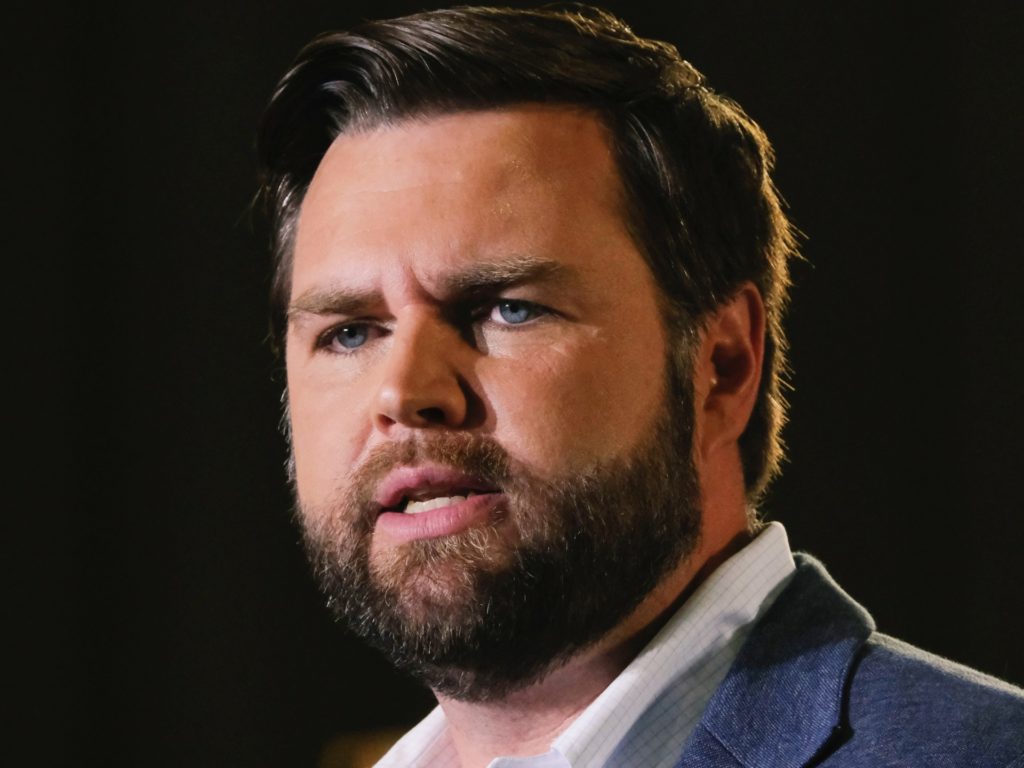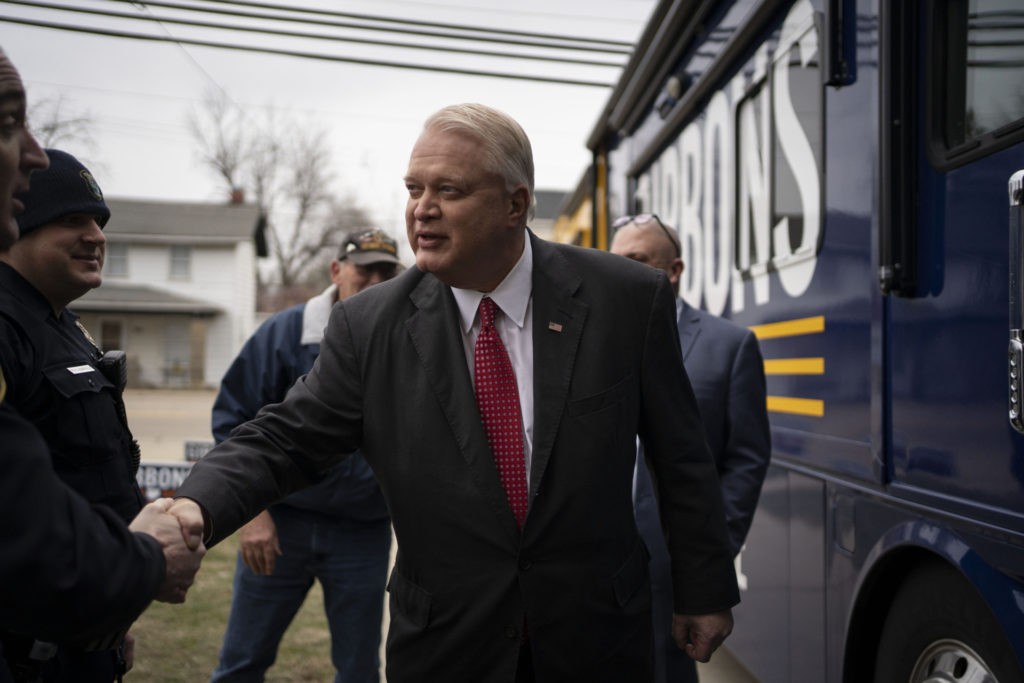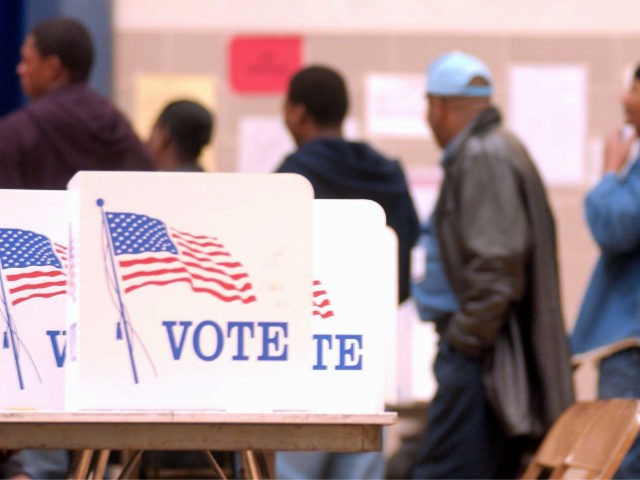A pair of polls in Ohio’s GOP U.S. Senate primary this week seem to indicate a significantly different landscape in the crowded field to succeed retiring Sen. Rob Portman (R-OH), signaling what may come down to a two-man race between author J.D. Vance and businessman Mike Gibbons.
One of the polls is an internal survey conducted by former President Donald Trump’s pollster Tony Fabrizio’s firm for the pro-Vance Super PAC Protect Ohio Values and the other is a public poll conducted by Emerson, the Hill, and a local news outlet in Ohio.
The Fabrizio, Lee & Associates poll, per a memo from pollsters David Lee and Travis Tunis to the Protect Ohio Values PAC folks obtained by Breitbart News, shows Gibbons leading with 18 percent and Vance tied for second with previous frontrunner Josh Mandel at 14 percent each. Jane Timken, the former chairwoman of the Ohio GOP, is down in fourth place at 12 percent and anti-Trump Matt Dolan is at 8 percent with 34 percent undecided.
The poll of 800 likely GOP primary voters was conducted from Feb. 23 to Feb. 24 and has a margin of error of 3.46 percent.
The polling memo has some other interesting facts that seem to bode well for Vance’s prospects in the final eight weeks of the primary as well. First off, the Super PAC just went up on television in the past few weeks with a new advertisement boosting Vance—something that seems to be working. Among those who have seen the ad, the pollsters note, Vance actually leads the field of GOP primary voters with 24 percent—overtaking Gibbons’ 19 percent among that subset of the sample. Mandel drops down to 12 percent among that subset, too, but the real movement is among undecideds who break big time for Vance—whose total is 10 points higher, while undecideds are 10 points lower, in the subset of the sample who have seen the pro-Vance Super PAC ad.

J.D. Vance, the venture capitalist and author of “Hillbilly Elegy”, addresses a rally Thursday, July 1, 2021, in Middletown, Ohio. (AP Photo/Jeff Dean)
“The data clearly shows Vance trending in a positive direction since the last survey and while the latest Protect Ohio Values ad was educating Ohio RPV about J.D. Vance,” the pollsters write in the memo. “We need to continue doing more of the same going forward to define Vance to Ohio RPV.”

Senatorial candidate Mike Gibbons speaks with supporters during a campaign rally in Maineville, Ohio, Friday, Jan. 14, 2022. (AP Photo/Jeff Dean)
The pro-Vance Super PAC also provided Breitbart News with several other data points in the polling that do not appear in the memo that are similarly interestingly and also bode well for Vance’s prospects. Specifically, on a series of likability questions, Vance has seen significant improvement in just the past month swinging momentum big time his direction.
When asked just generally if they would consider voting for him, since the Super PAC’s last survey in January, Vance has actually seen a 15-point net swing his way. In January, only 29 percent said they would consider him—while 32 percent said they would not—but in February he climbed 11 points to 40 percent with those who would consider backing him and dropped 4 points down to 28 percent who said they would not consider him.
Similarly, when asked if they view Vance as a conservative, moderate, or liberal, Vance has seen a huge swing month-over-month his way in those who view him as conservative. In January, just 27 percent viewed him as a conservative—but in February that number jumped 12 percent up to 39 percent. Both other questions—those who view him as a moderate or a liberal—dropped 3 percent apiece, meaning it’s a nearly 20-point image swing for Vance in total.
Vance’s favorability rating also saw a 7-point swing towards him, with 28 percent viewing him favorably in January and 35 percent in February—as compared with an unfavorable rating that remained almost unchanged month over month going up just one point from 28 to 29.
Vance’s hardcore opposition to U.S. military involvement in the Russia-Ukraine crisis—while drawing derision from the establishment media and even some of his GOP opponents such as Timken and Gibbons—seems extremely popular with GOP voters as well. An overwhelming majority explicitly said they oppose U.S. involvement in the conflict, siding with Vance against the others on this.
“As you may know, Russian military forces have recently occupied parts of Ukraine and have threatened to continue taking over other parts of the country,” began a question to survey respondents, which concluded with this: “Do you favor or oppose U.S. military forces engaging in fighting the Russian military to protect Ukraine from Russian occupation?”
A whopping 64 percent—a clear and convincing majority—said they were opposed, while only 25 percent favored U.S. military involvement and 11 percent did not know or refused to answer. Of the total, 45 percent—a clear plurality—were strongly opposed.
This survey comes on the heels of one earlier this week from Emerson, the Hill, and NBC4 in Ohio also showing Gibbons in the lead and Mandel slipping. That survey has Gibbons up at 22 percent, Mandel in second at 15 percent, Vance in third with 8 percent, and Timken and Dolan each at 6 percent.
Gibbons, a businessman who has spent millions upon millions building his image among likely GOP voters, seems to have risen up in part because he has gone largely untouched by the other candidates save for a couple swipes Vance has taken at him recently. Now that he is clearly out in front, expect a more thorough vetting of his background and past statements and positions—and a deeper look into his business history. Whether or not he maintains his lead will be determined by how strong other candidates’ hits on him are, and how he handles what is surely going to be a coming onslaught from the rest of the field.
While it’s clear that Gibbons is in the lead in both surveys, who else among the field will be left fighting until the final bell remains to be seen. The pro-Vance Super PAC survey shows Vance and Mandel tied for second, whereas the public poll shows Mandel in second with Vance in third—but one thing seems to be clear from where this race has turned based off the amalgamation of these latest surveys: Mandel’s fall from the lead is almost fatal for his campaign’s chances. Mandel’s pathway to the nomination was always remaining out in front the whole race and not slipping from the lead ever. Mandel held a weak lead over the field for nearly a year ever since the field developed, and his fall from that position bodes poorly for his chances. Now that he has fallen out of the lead, Mandel is in serious trouble as the other campaigns have shown his glass jaw can be broken and his previous lead was clearly not as insurmountable as he would have hoped. Regaining momentum and changing such a downward trajectory is always difficult in politics, especially in a crowded field where there is little opportunity for breakout moments and especially when local media does not provide in-depth coverage of the race.
While Mandel might still turn it around, these revelations do seem to suggest that the movement toward Vance in recent weeks and the upsides he is seeing in his surveys show Vance probably has the best shot of overtaking Gibbons in the end. How that battle shakes out—with Vance likely to force a conversation on globalization, immigration, outsourcing, trade, and war, all strong points of his and potentially weak points for Gibbons—remains to be seen. Time is of the essence for all parties concerned, especially if Ohio sticks with its scheduled May 3 primary, as there has been some rumbling the date may move because of redistricting issues in congressional races and money may become a major factor in the end. Vance is the only campaign not yet on television—his Super PAC is up but his campaign is holding its fire for the home stretch—and Gibbons seems to have an endless cash supply as a self-funder.
What would be tragic for those hoping for a true populist nationalist shift in this U.S. Senate seat—open primaries often represent an opportunity for the movement’s true believers to swing the balance of power more their direction and make general improvements to the party—is if an establishment-backed candidate such as Timken or worse Dolan could seize on the chaos and swoop in and take it back for the swamp. Timken’s family’s business ties to China—and as recently revealed, Russia, too—directly contradict her attempted portrayal of herself as a Trump ally. Dolan, meanwhile, has openly disagreed with Trump’s vision for the GOP, and his father—who owns Cleveland’s Major League Baseball team—literally changed the Cleveland Indians to the Cleveland Guardians to appease woke leftists. Trump has already publicly announced opposition to Dolan even though he has not yet endorsed among the rest of the candidates.
Maybe the race takes another interesting turn or two between now and the May 3 primary, with perhaps a candidate or two leaving the field to help make sure a true ally of Trump’s vision wins the primary. That already happened in recent weeks with businessman Bernie Moreno dropping out of the field to avoid splitting the vote. Maybe that will happen again with one or more of the other candidates, but how this race concludes—especially if the primary stays on May 3—could have major national implications as it could set the tone for what happens in other states giving whichever side of the GOP wins this race momentum and by blunting the losing side of the party in other states.

COMMENTS
Please let us know if you're having issues with commenting.